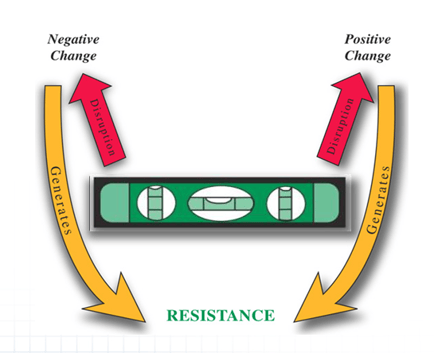The emotions Targets feel during an organizational change can easily be compared to a monster roller coaster. There are ups, downs, curves, slow climbs, fast descents, unexpected speed changes, and head-snapping starts and stops. But we know what you are probably thinking. You think this time it is going to be different  because this change is a positive one! It is going to make things better for everyone involved. So why are people still grumbling?
because this change is a positive one! It is going to make things better for everyone involved. So why are people still grumbling?
Surprisingly, even positive changes create a roller coaster of emotions. Think about getting married, or receiving a long-awaited promotion. These are definitely considered positive changes, but a roller coaster of emotion often still follows.
Here are three reminders about positive change:
-
Frames of reference are different! What is a "positive change" to one group of people may not be perceived as positive by another group.
-
The fact that you are dealing with a "positive change" has nothing to do with the levels of resistance you will encounter. The level of resistance is directly linked to the level of disruption created by the change. Not from your Frame of Reference, but from the Frame of Reference of the individual Targets.
-
Even positive changes require a structured approach to implementation.
It’s All About Frame of Reference
An important point to remember during any change, whether it is perceived as negative or positive, is that different people will have different reactions to the change. The truth is that what's positive to you or your senior leaders may not be so positive to the Targets of the change. From their "Frame of Reference," the change may create a lot of uncertainty and disruption.
There are various methods to diagnostically measure the level of disruption from the Frame of Reference of each Target. The easiest (and most often overlooked) technique is simply asking questions and then listening to the answers. Radical, right!?! Other methods include (but are not limited to):
- Focus groups
- E-Surveys
- Team Meetings
- Q&A Sheets
- Hot Lines
No matter what technique you use, remember that no communication should go out without a feedback loop attached to it. It’s an excellent way to gather information about sources of resistance to change.
Resistance is Inevitable
Resistance is not generated by whether or not people like your change—it’s caused by the degree of disruption  to their habits or patterns {Tweet This}. Remember, resistance is a function of the amount of disruption the change creates for the individual. It’s a way for people to protect themselves against changes in their job tasks, work behaviors, performance measures, power and/or status. In fact, you can anticipate that the more someone believes their current habits and patterns will be impacted, the greater the degree of resistance you will face.
to their habits or patterns {Tweet This}. Remember, resistance is a function of the amount of disruption the change creates for the individual. It’s a way for people to protect themselves against changes in their job tasks, work behaviors, performance measures, power and/or status. In fact, you can anticipate that the more someone believes their current habits and patterns will be impacted, the greater the degree of resistance you will face.
Sure it's frustrating, especially when you think your change will make things better for the people who are affected by the change. But remember Frame of Reference? Just because this change seems positive to you, it may not be so positive to the Targets of the change. The on-going challenge for Change Agents and Sponsors is to understand all the Frames of Reference affected by the change.
Structured Approach
If you are dealing change, whether it is perceived as negative or positive, utilizing a structured approach such as IMA’s proprietary Accelerating Implementation Methodology (AIM) can help. Here are some tactics from AIM on how to handle resistance to positive changes:
- Don’t oversell the benefits of the change. Communicate realistically that problems existed before, and this change is not a magic bullet.
- Acknowledge that there is both positive and negative data.
- Develop a problem-solving climate. Even if Targets aren’t involved in the “what” of the change, have them involved in the “how”.
- Create a safe atmosphere so that you can surface the resistance. This is not a one-time event, but a continuous process.
- Build confidence by communicating progress.
- Separate the content of the resistance from the process. Even if you disagree with the content, recognize and reward the fact that resistance is being brought out into the open.
If you are going through an organizational change, even if it is being perceived as positive, resistance is unavoidable. It may be out in the open, or lurking in a dark corner. But trust us... it’s there. If you take the time to surface resistance, understand it, and then manage it, your implementation has a much better chance at full optimization.


